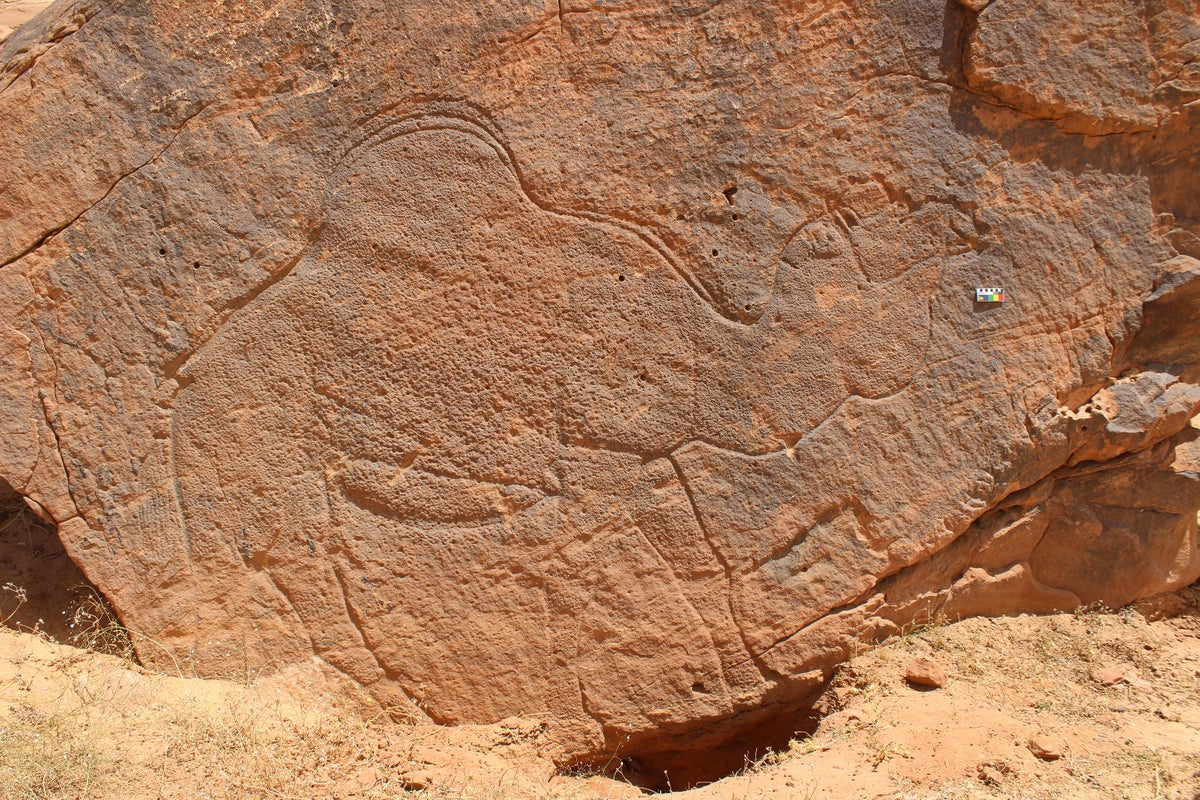Camels in ancient Arabia may have led hunter-gatherers through deserts once thought uninhabitable
Camel engravings indicate paths to ancient oases at four remote sites
If you’re enjoying this article, consider supporting our award-winning journalism by subscribing. By purchasing a subscription you are helping to ensure the future of impactful stories about the discoveries and ideas shaping our world today.
Composite drone photograph showing a panel of rock art at Jebel Misma, featuring 19 life-sized camels and 3 equids. Earlier depictions are traced in white and later ones in blue. A human outline is at left for scale.
On that morning, one of Shipton’s sharp-eyed assistants, Saleh Idris, looked up and exclaimed, “Jamal, jamal!” (camel in Arabic). Shipton looked up as well and, he recalls, “suddenly the sun came round enough so you could see them on the whole cliff, and I was like, ‘Oh, my God, it’s covered in them.’”
“It’s a bit of Indiana Jones,” Guagnin says, “because you can only see it for about an hour and a half in the morning, when the sun rises, and it comes up over the mountain, and it hits it just right. And then the sun rises a bit further, you lose all of the contrast, and it’s invisible until the next morning.”
Rock art panels at Jebel Arnaan. Tracings highlight the layering of engravings, showing phase 1 in green, phase 2 in yellow, phase 3 in white and phase 4 in shades of blue.
These carvings sit just above a ledge barely wide enough to get a foothold, on a sheer rock face more than 100 feet high. “So that means they had the rock surface directly in front of their nose, and at no point would they be able to see the whole animal. They must have had an engraving tool and just basically hammered it…, going from one side to the other, and somehow created this whole animal along the rock surface,” Guagnin says.
Many of the camel carvings are layered one on top of the other and vary slightly in style over time, from realistic to more cartoonish and abstract—a progression, Guagnin says, that could mean the artists were developing a shared concept of the camel. The continuous effort to update the carvings establishes their use over long periods. The researchers propose they were intended to guide thirsty hunter-gatherers to water sources that were often concealed behind boulders and sandstone formations and to mark access rights.
Martin J. Kernan is a journalist from central New York State who writes about science and history.
If you enjoyed this article, I’d like to ask for your support. Scientific American has served as an advocate for science and industry for 180 years, and right now may be the most critical moment in that two-century history.
I’ve been a Scientific American subscriber since I was 12 years old, and it helped shape the way I look at the world. SciAm always educates and delights me, and inspires a sense of awe for our vast, beautiful universe. I hope it does that for you, too.
If you , you help ensure that our coverage is centered on meaningful research and discovery; that we have the resources to report on the decisions that threaten labs across the U.S.; and that we support both budding and working scientists at a time when the value of science itself too often goes unrecognized.
In return, you get essential news, captivating podcasts, brilliant infographics, , must-watch videos, challenging games, and the science world’s best writing and reporting. You can even gift someone a subscription.
There has never been a more important time for us to stand up and show why science matters. I hope you’ll support us in that mission.
Thank you,
David M. Ewalt, Editor in Chief, Scientific American
Source: www.scientificamerican.com
